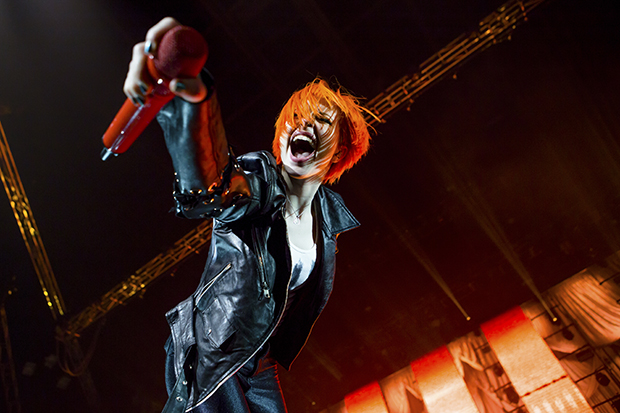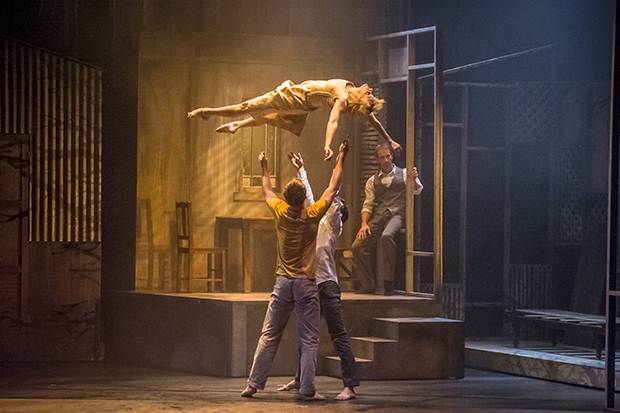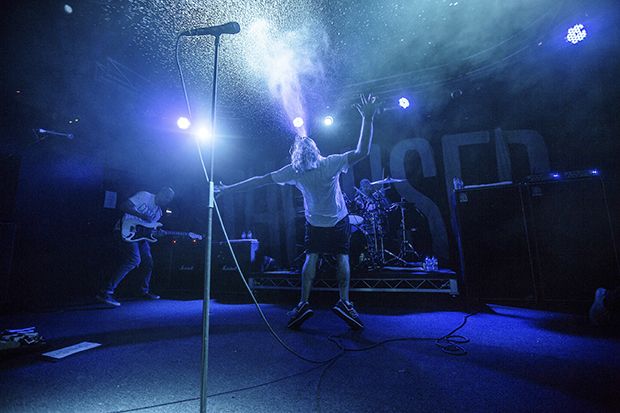Shooting stage performances requires planning, skill and instinctive timing. Rob Ditessa talked to three experts who share their best tips and tricks for capturing dynamic and memorable images.
"I always try to capture the vibe of the show so when a fan or someone else looks at the photographs they can feel like they were at the show. In the end, I'm getting the opportunity to document part of an artist's history, and that's a pretty special thing," enthuses Sammy Roenfeldt who specialises in rock music performance photography. He always brought along his camera to rock concerts to snap his favourite performers, but felt a little jealous of the professional photographers who got the best locations and access to shoot the action up close. Eventually, fired by his passion, Roenfeldt acquired a good SLR, taught himself the skills to go with it, and negotiated access through musician friends. Soon he was shooting local bands on assignment for music magazines, covering the 10th anniversary Soundwave Festival, one of Australia's biggest music events. Everything fell into place when he shot Paramore and the band posted many of his images on its website. His career snow-balled from there and he has now spent the last two years travelling around Australia and the world documenting bands on the road both on and off stage.
Another performance photographer, Chris Herzfeld, says, "My whole philosophy is that I want to take a shot so when it's reproduced in a magazine or a newspaper, you're going to stop and look at it and get a feeling for what the show is like. Hopefully it will make you want to see the show."
With a cinematographer photographer father, Herzfeld grew up in an environment filled with "a million cameras" and he reflects it was natural for him to go into photography. He began working as a professional performance photographer in 2003, as the photographic technical manager on Australian Dance Theatre's (ADT) major project 'HELD', alongside New York dance photographer Lois Greenfield.
"I have found that although a performance subtly changes every night, there are moments that jump out at you that are really strong, and that as an audience member you'll remember. It's those types of moments that you want to capture," he says.
Meanwhile, Philippe Penel explains, "I'm seeking to capture the essence of what the performer is projecting, but also the theatrical lighting and ambience, which can be dramatic. The best performers make you feel many emotions, and they make you forget their technical and acting skills, the countless hours of practise. You're left with the raw beauty of the act, and that is what I seek to portray in my images."
Penel always liked photography, and remembering how he played with cameras as a child, he muses there must be a photography gene in his family because his brother is a photographer as well. He took up the craft professionally when a relative encouraged him to follow his passion. At first he did everything, from weddings to corporate work. As the years went by, though, he became more focused with a deepening interest in capturing movement, especially in the performing arts. Now, with years of experience, he captures movement instinctively. In fact he says if he consciously thinks about when to press the trigger, he can miss the moment!
Josh Franceschi of You Me At Six. Canon 5D Mk III, 24-70mm f/2.8 lens @ 24mm, 1/320s @ f/2.8, ISO 800. Photo by Sammy Roenfeldt.
BEHIND THE MOMENT
Herzfeld says there's no easy answer to that million-dollar question about when to push the shutter button to capture the right, most revealing moment. His two decades as a television cameraman covering sport was great training for shooting performance, particularly dance. He learned how to read the plays, the movement of the event, and simultaneously coordinate hands, head and eyes. Capturing the right moment becomes ingrained somehow, like fine cooking becomes ingrained in great chefs. He says seeing a performance of theatre or dance before you shoot it is a valuable opportunity to acquaint yourself with costumes, lighting, where the performers will be and how they interact with the set. If you have shot the rehearsals you'll find that once the show is on stage with lighting and costuming, it can look quite different.
Roenfeldt echoes those sentiments, and adds that every show is different and anything can happen. But he emphasises that research will improve your chances of capturing compelling images. With the internet you can view bands online to observe, for instance, any iconic moves and get a "general vibe" of how the artists perform on stage.
"The key for me is doing a bit of research before each show, working out simple things such as whether the lead singer is left or right handed. If you know that, it will help you identify where to stand in front of stage. If they're right handed and you're standing on the right of the artist, the microphone will cover their face. But if you position yourself on the left, it opens you up to getting shots of their facial expressions," he explains.
It all comes down to experience, Penel says, drawn from years of practice and studying your own and other's work, to know what looks good in two dimensions. You have to be prepared and know, for instance, when the dancer is about to do a grand jeté or a back flip. He advises beginners to get to know their genre. If you want to capture ballet, go to ballet performances. If you prefer circus or hip-hop go to those shows. He says they're all similar, but different. 
Hayley Williams of Paramore. Canon 5D Mk III, 24-70mm f/2.8 lens @ 24mm, 1/400s @ f/3.2, ISO 1600. Photo by Sammy Roenfeldt.
BEST TECHNIQUES
Turning away from the psychology to technical issues, Herzfeld nominates setting the camera on automatic as the biggest mistake first-time performance shooters can make. He urges beginners to shoot everything in manual mode. "I try to max out everything. I generally shoot between ISO 8,000 and 10,000. With my Nikon D4, I'd be shooting closer to ISO 20,000. I do pick the lowest ISO setting possible in the circumstances to reduce the noise. I try to then shoot on the highest shutter speed with the greatest depth of field. This changes right throughout the performance, and you're continuously changing absolutely everything," he explains.
He recommends people use manual focus because modern cameras aren't quick enough. Autofocus is designed for movements generally left to right, or right to left, and are not designed, and do not work well, when objects are moving towards you, and then quickly moving away from you.
"For most performances I'll put up to four cameras in the theatre if I can. I operate one and I'll use three with pocket wizard remotes to trigger them. With the low-percentage shots, I might only get one or two from those cameras, but that enables me to get a far greater coverage. I use a D800 and a couple of Nikon D3s, and a D3S, when I'm doing that."
For performance photography, Penel suggests you can use any camera with good low-light capabilities. Use the smallest f-number – the widest aperture – with an ISO of 200 for studio shooting, and between 200 and 64,000 for performances. He recommends including a couple of lenses in your kit – a 24-70mm for up close work, and a 70-200mm for distant shots. A tripod is useful if you use a heavy zoom. He aims to avoid flash as it kills the theatrical lighting. Don't move too much so you can avoid camera shake, and focus on the main performers as the depth of field is usually quite shallow, especially with a long telephoto or zoom. During a performance, he says, you have no control over the lighting, and to avoid glare, you'll need to change your position. If the lighting is bad, you can attempt a more artistic interpretation. The colour balance is also likely to be all over the place, but you can correct it to some extent in post-production software, particularly if you shoot RAW which offers more flexibility in post production. In a studio shoot, he aims for simplicity and emphasis on the performer's skills, grace, flexibility, or strength. He says his set-up depends on the scope of the shoot, of course, and what he wants to achieve.
"As I do shoots in and out of the studio using different backgrounds, they all require different techniques and creative lighting, from using large soft boxes to grids, scrim and reflectors," says Penel.
When it comes to choosing a camera, Herzfeld empasises the importance of fast shutter response. "Once you press the button you want the shutter to fire. You don't want there to be any sort of lag because dancers move incredibly fast," he says.
He points out that digital cameras have a longer shutter lag compared to the old film cameras. Your camera should have a short lag and also superior low-light capabilities. Remember that in some situations you do not really have the time to change lenses during the performance. In some theatres the only place you're allowed to shoot from is the back row, so you're forced to use a telephoto lens.
"The further away from the stage you are, the less distance you have to pan the camera to follow a dancer moving on stage, therefore having the effect of slowing the movement down," says Herzfeld.
"If you use a wide angle and you're sitting in the front row, you have to pan the camera much further and more quickly to follow the same movement." He recommends enthusiasts don't use filters for any reason because "you don't want anything in front of the lens to hamper the light struggling to get through".
Roenfeldt reflects that the biggest mistake novice performance photographers make (and he confesses to being guilty of it at the start) is being "trigger happy". Take your time, he counsels, have your camera at the ready, look for the right moment and then take your shot. For rock performances, you need a camera where you feel in easy control of ISO, shutter speed, and aperture. Shoot no slower than 1/200s for live music situations, he says. A high shutter speed is the key to capturing an artist in a fast movement shot. The aperture he normally works with ranges between f/2.8 and f/3.5, and he sets the ISO accordingly.
The faster the lens the better, especially when you start out, because you'll be shooting smaller shows where the lighting and the ambience changes continuously. A 50mm f/1.8 is a good lens to begin with, being relatively inexpensive, but good in low light. "As much as you may want to use flash, do not use it in live performances," he says. "It's distracting, it ruins the vibe of the show, and the capture is not true to the show itself. Find ways to make the show's lighting work for you."
If he's shooting with f/2.8 at 1/200s and the image is still dark, he will bump up the ISO rating. Don't be afraid of some noise in the photos if it means you can shoot with a higher shutter speed, he says. Roenfeldt always uses evaluative metering and shoots in burst mode, especially for moments such as a jumping shot, where he can snap action in progress.
Anthony Takataka, DC Academy, Sydney. Nikon D610, 80-200mm lens, 1/400s @ f/2.8, ISO 5000. Shot in RAW, very little image manipulation, sharpening and noise softening. Photo by Philippe Penel.
SHOOTING ETIQUETTE
In a darkened theatre you obviously want to avoid blazing away with flash, but you should also turn off infrared. Be respectful to the performers and the artistic team in general, Herzfeld says. If you're there to do a job, particularly in dance, it's incredibly dangerous for the dancers if you get in their way. If you cause an injury to a dancer you are likely to never work in that theatre again!
When Herzfeld shoots with an audience in the theatre he'll organise for a few seats to be left free around him so he doesn't discomfort the paying public. In those circumstances, he says he uses his D3S because it has a silent mode, and most festivals and theatres will request it. When you go to a theatre, make sure you know who is who and who controls what – for instance, stage managers, or company managers.
Penel adds that most theatres prohibit the shooting of performances except for professional photographers when they are hired by the studio or theatre. When there are children involved you'll also need a "working with children" certificate.
Roenfeldt notes rock music concert photography is a lot different from any other style in terms of the permissions and authorisations you may need to obtain. Most venues will not let you just bring in an SLR camera. Local bands appreciate getting images of their performances, so contact them. For bigger shows you will need to be shooting for a publication or for the band themselves. He says novices will have to sign photo release forms which might state they can only use their images for a certain publication at a certain time. He cautions, "Some release forms are ridiculous and basically you give up all your rights to the photo." Make sure you read any contracts carefully before you sign them. And remember, you're there to document the performance, but don't get in the way of fans who have paid good money to see their favourite bands perform.
Photo by Chris Herzfeld.
PHILIPPE PENEL ON POST-PRODUCTION
Penel says, "I work with RAW format and I choose the best shots in Adobe Bridge. I'll correct the colour balance, especially for stage performances. I clean up skin imperfections, but I don't go overboard unless a client specifically requests it."
Penel says the most difficult problem to fix in post-production is skin colour in some situations when the stage colours are mono-coloured, like bright red or green.
Artist Emma Phillips, photographed in studio. "I used one large soft box at camera left," says photographer Philippe Penel. Nikon D610, 24-70mm f/2.8 lens @ 35mm, 1/250s @ f/18, ISO 250. Shot in RAW, medium image manipulation, sharpening and noise softening, removal of skin blemishes.
SAMMY ROENFELDT ON POST-PRODUCTION
Roenfeldt says, "I'm pretty OCD when it comes to my file management and work-flow. All the gigs I shoot are in band folders dated for each show, and so on. As for editing, I use Adobe Bridge to sort through my photos. First thing I do is to load my photos in Bridge then go through them one by one, selecting the ones I like. I then go for a second look through these, culling ones which are similar. For me, when I'm taking live photos, less is more. You don't need to post two photos of essentially the same pose. I then open up my images in Adobe Camera RAW and do all my touch-ups in there. To be honest, I don't do a whole heap with my live photos other than enhance what's already there. I think this is really important. I'll adjust the white balance to bring out natural skin tones wherever possible and then just highlights, shadows, and so on using curves. I also play around with saturation and luminance with the colours a bit, just to make the photo 'pop' a bit more. For the better part each photo will only take me a few minutes to edit. On the odd occasion I will bring a live photo into Photoshop to remove a stray mic stand or something if it's distracting from the photo. But ideally I like keeping the photo as true to the environment I shot in as possible."
Bert McCracken of The Used. Canon 5D Mk III, 16-35mm f/2.8 lens @ 16mm, 1/320s @ f/2.8, ISO 1600. Photo by Sammy Roenfeldt.
CHRIS HERZFELD ON POST-PRODUCTION
Herzfeld says he shoots "as clean as possible" to minimise the time he has to spend in post-production. His work doesn't involve any Photoshop pasting or cutting. His philosophy is that what you see is what you get.
"I don't use trampolines or harnesses. I don't pose the dancers. The dancers are moving in my shots. I don't use a motor winder. All shots are 'one takes'. The dancers jump and the shot is taken, with usually no more than six shots per set up."
He shoots in RAW mode, and everything gets processed because under mercury vapour or fluoro lighting the camera will throw up a different colour. He takes this approach even if it means overnight turnarounds. He agrees it's time consuming, but he says, "It depends on how you want your images to be seen. I use mainly what you'd class as traditional darkroom techniques – dodging, burning, colour correction, exposure, and because I'm not cutting or pasting, we're not adding elements to the images. I try to set up efficient work flows for post-production by using batch processing as much as possible, but particularly with the rehearsal shots I end up having to make adjustments to each shot."
Photo by Chris Herzfeld. "I'm lucky in that I sponsor a number of independent choreographers who are also good friends and they let me go anywhere in the theatre to get the shots I need," says Herzfeld. "This shot was taken from the wings through the final rehearsal. To get these types of shots you need a very good relationship with not only the dance company but also the theatre. Always ask before attempting these shots. The dancers are, left to right: Kialea Nadine Williams, Kimball Wong, Madeline Edwards, and Alex Baden Bryce. This was taken from Daniel Jaber's 'Agile'." Nikon D3S, 24-70mm f/2.8 lens @ 36mm, 1/500s @ f/4, ISO 10000, handheld.










